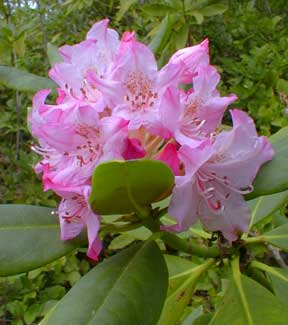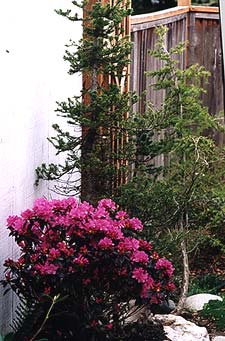 Mad Honey Disease:
Mad Honey Disease:
Bees & Rhododendrons
"Oh, they ate and drank & bragged no end
about what they were gonna do.
while they scarfed up Rhododendron Honey
and Amanita Stew."
-Leslie Fish,
1989
1989
Now & then one encounters the folklorishly exaggerated "warning" that rhododendron flowers are so poisonous that bees manufacture toxic honey from them. This honey when ingested allegedily will induce illness & hallucinations.
These warnings are invariably punctuated with the stories of Xenophon's army sickened near the Black Sea region for having eaten the madness honey. The locals along the Black Sea repeated the stunt against General Pompey a few centuries later. And the tactic purportedly worked again when the much-legended amazonian Queen Olga of medieval Kiev gave tribute of Black Sea honey to invading Russians, then killed the lot of them while they were in hallucinatory stupors.
 One reason all the editorialists mention the incidents of Xenophon in 401 B.C.E. & Pompey in 69 B.C.E. is because they have trouble finding much that is more recent. Since the number of documented cases of "mad honey disease" in the United States in the last quarter-century add up to exactly none it'd be merely paranoid to worry about it. If, however, you find yourself a hive while on holiday in the Taurus Mountains, then perhaps you should be prepared for a hangover & with luck a few exciting visions, if you eat that stuff raw, comb & all, in gluttonous quantities.
One reason all the editorialists mention the incidents of Xenophon in 401 B.C.E. & Pompey in 69 B.C.E. is because they have trouble finding much that is more recent. Since the number of documented cases of "mad honey disease" in the United States in the last quarter-century add up to exactly none it'd be merely paranoid to worry about it. If, however, you find yourself a hive while on holiday in the Taurus Mountains, then perhaps you should be prepared for a hangover & with luck a few exciting visions, if you eat that stuff raw, comb & all, in gluttonous quantities.Some historians speculate that the ancient Greek maenadic virgin cult of Melissai ("Bees"), who gave prophesies in the manner of entranced sibyls, induced their own trances by means of drunkenness on mead made from mad honey. As late as the 17th Century, tavernerers & innkeepers sometimes offered Mad Honey to sweeten drinks, & tons of it were exported from Turkey for this purpose.
But to extend these historical realities to modern rhododendron gardening & bee keeping verges on the absurd. The restricting factors are that not many rhododendrons actually produce measurable amounts of the toxin in question. For the few that do so, by the time bees had gleaned enough from the flowers to produce a toxic honey, they wll probably have poisoned themselves, not having the same adaptation to the toxins that Pontus bees acquired over time. The reason some rhodies produce these toxins is to keep insects off of them, & while bees may pollinate the flowers with moderate attention without injury, if they gleaned precisely the correct species & nothing else, they would likely injure their own hive long before they produced enough honey for human consumption. But the potentially offending species species tend to be in bloom only a couple weeks in the wild & no hive will have gleaned much from just these flowers, though in some areas bees have killed themselves over-harvesting loco weed or mountain laurel.
In North America, laurel & andromedas are more apt to toxify honey, but again by the time it is toxic enough to harm a human, the hive itself is at peril. Of my fairly large collection of rhodies, none are sufficiently toxic to be a danger to pets, children, or adults, even if we were dumb enough to brew a tea from the leaves & chug a lot of it daily.
It it were really possible to get the hallucinogenic effects, rhody tea would be so popular that every gardener would be at risk of waking up one morning to discover teenagers had snuck into the yard & harvested the rhody bushes down to twigs.
Most North American reports of grayanotoxin poisoning through honey have actually involved Kalmia spp, not rhododendrons, & animals, not people. No east coast rhododendron species has enough of the toxin to affect honey. Though the toxin is to be found in three west coast native rhody species in high enough concentrations to make ruminants, dogs, or children sick if they eat the leaves, this means nearly all reported cases of grayanotoxin poisoning have been ruminants eating leaves, not people eating honey.
In theory, though not in reported actuality, if a hive spent the two or three weeks that Rhododendron albiflorum is blooming here in the Northwest, gleaning from nothing else, a toxic honey could result. The other two west coast species with grayanotoxin are R. occidentale & R. macrophyllum. the latter shown in in the April photo above. Yet despite that these shrubs, & beekeeping, are commonly in proximity to one another all up & down the cost, no cases of mad honey disease has ever been reported anywhere in R. albiflorum's extensive range. So it's a little like worrying about if you should happen to jump as high as the moon, you'd definitely suffocate.
R. ponticum from the Black Sea region is the most toxic rhody, with local bee populations adapted to the toxin. It is the only rhody associated with any of the historical incidents noted by such authors as Pliny & Strabo & Xenophon. The scant handful of documented cases of mad honey disease in humans in the last 25 years have all been either in Turkey where R. ponticum is a common wild shrub (or small tree), or from honey exported from Turkey.
The species was introduced into British parklands a century ago & has become invasive in a few forested regions. Yet no toxic honey has ever been reported from these regions because the bees aren't adapted to the toxins, the toxins are not as concentrated in plants grown in moist sea level regions rather than arid mountainous zones, & bees do not glean enough from the west asian species in the UK to have had any reported impact on honey.
Many commonly gardened rhodies such as the PJMs (the second photo shows 'PJM Elite') have a mild amount of toxin that makes it unwise to eat the leathery leaves, but no honey intoxication has ever been associated with these extremely mildly toxic hybrids. Only the most neurotic dog could eat enough of it to get mildly ill (a lethal dose would require so many leaves & flowers the bulk of it would far exceed the size of the stomach).
In South America where wasp honey is eaten, honey made by wasps of the genus Polybea, when they glean jimsonweed & other plants of the potato family, can be toxic due to atropine. It is hallucinogenic, increases susceptibility to heat stroke, dehydration, with a possibility of death. This too is extremely rare even where people eat wasp honeycombs raw, in areas where toxic potato-family plants are long in bloom.
While one finds numerous editorials by alarmists without citations that rhodies in the presence of hives makes the honey deadly, when one looks for actual reported cases of grayanotoxin poisoning, they are either veterinarian reports, or cases restricted to R. ponticus honey from Turkey. To worry about it is as sensible as worrying about being poisoned by Phytohaemagglutinin in the common kidney bean. Or apples. My god apples! They've got cyanide in them; & since an apple nearly killed Snow White, we'd all better be worried about it!